Closed Circuit Dry Grinding Ball Mill: Working Principle and Advantages
Closed Circuit Dry Grinding Ball Mill: Working Principle and Advantages
In the mineral processing and grinding industry, the Closed Circuit Dry Grinding Ball Mill stands out as a highly efficient and reliable solution for producing fine powders. This article delves into its working principle, key advantages, and why it’s a preferred choice for many industrial applications.
Working Principle
The Closed Circuit Dry Grinding Ball Mill operates on a simple yet effective mechanism. Here’s a step-by-step breakdown:
- Material Feeding: Raw materials with a size of less than 25mm are fed into the mill through a hopper or vibrating feeder.
- Grinding Process: The materials enter the grinding chamber, where steel balls of varying sizes rotate horizontally. The centrifugal force generated by the rotation lifts the balls to a certain height, causing them to fall and impact the materials, grinding them into finer particles.
- Classification: The ground materials are carried by airflow to a classifier (e.g., a dynamic separator). Coarse particles are returned to the grinding chamber for further milling, while fine particles proceed to the collection system.
- Product Collection: The fine powder is collected in a cyclone separator or bag filter, ensuring minimal dust emission and high product purity.

Advantages of Closed Circuit Dry Grinding Ball Mill
- Energy Efficiency: The closed-circuit design reduces over-grinding and optimizes energy consumption, saving up to 30% compared to open-circuit systems.
- High Fineness Control: Advanced classifiers allow precise control over particle size distribution, ensuring consistent product quality.
- Low Maintenance: Robust construction and durable components (e.g., high-chrome grinding media) minimize wear and extend operational life.
- Environmental Friendly: Equipped with pulse dust collectors and mufflers, the system operates with minimal noise and dust pollution.
- Versatility: Suitable for grinding a wide range of materials, including limestone, cement clinker, and metallic ores.
Recommended Product: MW Ultrafine Grinding Mill
For customers seeking even finer powder production, our MW Ultrafine Grinding Mill is an excellent alternative. Key features include:
- Input Size: 0-20 mm
- Capacity: 0.5-25 tph
- Fineness: Adjustable between 325-2500 meshes (d97≤5μm achievable)
- Eco-Friendly: Integrated pulse dust collector and noise reduction technology.

The MW Ultrafine Grinding Mill is ideal for industries requiring ultra-fine powders, such as cosmetics, pharmaceuticals, and advanced ceramics. Its innovative design ensures higher yield and lower energy consumption compared to traditional ball mills.
Conclusion
The Closed Circuit Dry Grinding Ball Mill is a cornerstone of modern grinding technology, offering efficiency, precision, and sustainability. For specialized applications demanding ultra-fine powders, our MW Ultrafine Grinding Mill provides a cutting-edge solution. Both machines embody LIMING’s commitment to innovation and environmental responsibility.

Explore our product range to find the perfect grinding solution for your needs!
